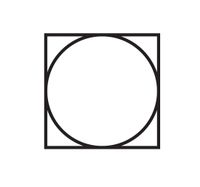Question
Consider the diagram below showing 2 two current loops (a square and circle centered about the same point. If the currents in each loop are in opposite directions and the current in the square loop is 3.13 A, what must the current in the circular loop be if the net magnetic field at the center is zero? Let the radius of the circle be 0.146 m.

Expert Solution
This question has been solved!
Explore an expertly crafted, step-by-step solution for a thorough understanding of key concepts.
This is a popular solution
Trending nowThis is a popular solution!
Step by stepSolved in 3 steps with 3 images

Knowledge Booster
Similar questions
- Please Asaparrow_forwardConsider a charged particle moving through a region in which the electric field is perpendicular to the magnetic field, with both fields perpendicular to the initial velocity of the particle (see figure below). Such a device is called a velocity selector because for one particular value of the particle speed select the particle will travel straight through the device without being deflected, whereas particles with speeds that are either less than or greater than Vselect will be deflected. Consider a case with E = 505 V/m and B = 0.11 T. B Perspective view AE = 'select v>F'select (a) When protons are used, what speed is selected? m/s (b) What is the speed selected for Ca²+ ions? m/s (c) If you were to use your selector with Fions, what change would be necessary?arrow_forwardA long straight wire is fixed in space and has current I. Draw the wire vertically with the current flowing upward. A square wire loop with side length s and resistance R is in the plane of the page and has its closest side a distance x away from the wire. Find the magnetic flux through the square HINT: The B-field depends on distance from the wire so you will have to integrate. The loop is pushed with velocity v toward the Find the rate of change of magnetic flux. HINT: Don't forget the chain rule. If f(x(t)) is a function of x and x is a function of t, then df/dt = (df/dx)(dx/dt) Find the current induced in the square Which direction is the current flowing? Explain with Lenz's Law Find the net magnetic force on thearrow_forward
- A long, cylindrical conductor of radius R carries a current I as shown in the figure below. The current density J, however, is not uniform over the cross-section of the conductor but is a function of the radius according to J = 2br, where b is a constant? Find an expression for the magnetic field magnitude B at the following distances, measured from the axis. (Use the following variables as necessary: ?0, r1, r2, b, R.) (a) r1 < R (b) r2 > Rarrow_forwardAs shown in the figure below, a circular ring with a radius of a is folded along a line across the diameter so that the two semicircles are perpendicular. In the magnetic field, this ring was rotated at a constant angular velocity over time, as shown in the figure. The axis of rotation is an extension of the fold-off line and is perpendicular to the magnetic field. The resistance of the ring is R. (1) Give a qualitative explanation of what will happen. (2)Find the current flowing through the ring. (3)What torque should be applied to the ring to allow it to rotate at a constant angular speed? (4)What do you have to do to turn it N round? (5) What energy changes from ring to heat? (6) How much energy changes from ring to heat? * I'll be so thankful and satisfied to get answer just least 3 of 6 questions..arrow_forwardConsider a long, horizontal Large Wire with current of 10 A running through it. We want to levitate a horizontal, thin, 0.50 m length of wire above it. If the thin wire has a mass of 10 grams, and a current of 300 mA, how far above the Large Wire will it hover (net force of zero) due to magnetic and gravitational forces? A. If the thin wire hovers above the Large Wire due to their magnetic fields, are their currents going the same direction, or opposite directions. Explain. B. Draw a diagram and label the directions of currents, and all other relevant quantities and vectors. C. Find the distance above the Large Wire the small thin wire will hover (net force of zero). D. Would your answers to parts A and C change if we wanted to find a distance below (rather than above) the Large Wire that the smaller thin wire could hover, due to their magnetic fields. Explain. Don't calculate any values but draw a new diagram and explain how this situation compares to the problem above.arrow_forward
arrow_back_ios
arrow_forward_ios